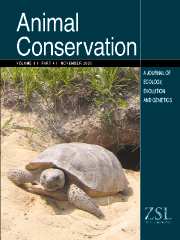Article contents
Conservation genetics of the endangered Shenandoah salamander (Plethodon shenandoah, Plethodontidae)
Published online by Cambridge University Press: 18 May 2001
Abstract
The Shenandoah salamander (Plethodon shenandoah) is restricted to three isolated talus outcrops in Shenandoah National Park, VA, USA and has one of the smallest ranges of any tetrapod vertebrate. This species was listed as endangered under the US Endangered Species Act in 1989 over concern that direct competition with the red-backed salamander (Plethodon cinereus), successional habitat changes, and human impacts may cause its decline and possible extinction. We address two issues herein: (1) whether extensive introgression (through long-term hybridization) is present between the two species and threatens the survival of P. shenandoah, and (2) the level of population structure within P. shenandoah. We provide evidence from mtDNA haplotypes that shows no genetic differentiation among the three isolates of P. shenandoah, suggesting that their fragmentation is a geologically recent event, and/or that the isolates are still connected by occasional gene flow. There is also no evidence for extensive introgression of alleles in either direction between P. cinereus and P. shenandoah, which suggests that P. shenandoah may not be in danger of being genetically swamped out through hybridization with P. cinereus.
- Type
- Research Article
- Information
- Copyright
- © 2001 The Zoological Society of London
- 8
- Cited by


